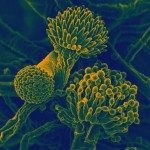Lien vers Pubmed [PMID] – 25786415
Dis Model Mech 2015 May;8(5):473-86
Studying infectious diseases requires suitable hosts for experimental in vivo infections. Recent years have seen the advent of many alternatives to murine infection models. However, the use of non-mammalian models is still controversial because it is often unclear how well findings from these systems predict virulence potential in humans or other mammals. Here, we compare the commonly used models, fruit fly and mouse (representing invertebrate and mammalian hosts), for their similarities and degree of correlation upon infection with a library of mutants of an important fungal pathogen, the yeast Candida glabrata. Using two indices, for fly survival time and for mouse fungal burden in specific organs, we show a good agreement between the models. We provide a suitable predictive model for estimating the virulence potential of C. glabrata mutants in the mouse from fly survival data. As examples, we found cell wall integrity mutants attenuated in flies, and mutants of a MAP kinase pathway had defective virulence in flies and reduced relative pathogen fitness in mice. In addition, mutants with strongly reduced in vitro growth generally, but not always, had reduced virulence in flies. Overall, we demonstrate that surveying Drosophila survival after infection is a suitable model to predict the outcome of murine infections, especially for severely attenuated C. glabrata mutants. Pre-screening of mutants in an invertebrate Drosophila model can, thus, provide a good estimate of the probability of finding a strain with reduced microbial burden in the mouse host.




